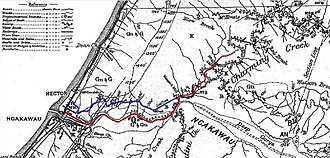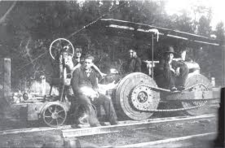Charming Creek Tramway
| Charming Creek Tramway | |||||||||||||||||||||||||||||||||||||||||||||||||||||||||||||||||||||||||||||||||||||
|---|---|---|---|---|---|---|---|---|---|---|---|---|---|---|---|---|---|---|---|---|---|---|---|---|---|---|---|---|---|---|---|---|---|---|---|---|---|---|---|---|---|---|---|---|---|---|---|---|---|---|---|---|---|---|---|---|---|---|---|---|---|---|---|---|---|---|---|---|---|---|---|---|---|---|---|---|---|---|---|---|---|---|---|---|---|
|
Self-built steam locomotive by Robert T. Watson with
a portable Ruston & Procter vertical boiler | |||||||||||||||||||||||||||||||||||||||||||||||||||||||||||||||||||||||||||||||||||||
|
Old (blue) and new (red) Charming Creek Tramway, 1914
| |||||||||||||||||||||||||||||||||||||||||||||||||||||||||||||||||||||||||||||||||||||
| Route length: | 9 km | ||||||||||||||||||||||||||||||||||||||||||||||||||||||||||||||||||||||||||||||||||||
| Gauge : | 1067 mm ( cape track ) | ||||||||||||||||||||||||||||||||||||||||||||||||||||||||||||||||||||||||||||||||||||
|
|||||||||||||||||||||||||||||||||||||||||||||||||||||||||||||||||||||||||||||||||||||
The Charming Creek Tramway was a nine-kilometer private forest and mine railway near Ngakawau in the Buller District of the West Coast region in New Zealand . It was in operation from 1903 or 1905 to 1958.
location

The forest railway with a gauge of 1067 mm (3 feet 6 inches ) initially brought long timber from the forest areas in Charming Creek Valley to the sawmill called Watson's Mill and from there to the Ngakawau station of the state New Zealand Rail (NZR) . The line was later also used by a mine railway to bring coal from the Charming Creek Coal Mine to the coal bunkers near Ngakawau for transfer to NZR wagons.
history
Forest railway
After the uninsured Granity Creek Sawmill owned by the brothers George and Robert Watson burned down under unexplained circumstances, their new Watson's Mill near Ngakawau began operations in 1903 or 1905. This location provided plenty of bush for logging and was close to an NZR railway line. In order to achieve this inexpensively, and because the steep Ngakawau Gorge was not a suitable route for draft animals, the Watson brothers built a forest railway from the sawmill on the north side of the Ngakawau River to Hector. This had a very steep section of the route that fell down to the mill, and was overcome with a funicular powered by an 8-hp steam winch set up on the hilltop. P. 7
Presumably because the first forest railway was uneconomical or inefficient to operate because of the funicular railway, a new forest railway was built between 1907 and 1912 from the mill through the steep lower Ngakawau Gorge to the railway line in Ngakawau. The construction of the forest railway was a technical masterpiece with complex cuts, embankments, tunnels and bridges. One of the tunnels was called the Irishmans Tunnel , which was constructed with an S-shaped curve to compensate for a mistake when the tunnel construction sites being driven from both sides would otherwise not have met. Because of the steep topography of the lower Ngakawau Gorge, this section of the route had many tight curves and a section with a very steep gradient of 1 in 7 (14 ‰).
Initially the route had wooden rails. These were replaced by steel rails in the 1920s when the use of steam locomotives and tractors converted into rail vehicles became common. The track gauge of the forest railway was the New Zealand Rail (NZR) standard of 3 feet 6 inches (1067 mm). Steep sections of the forest railway had a wooden middle track for braking with a skin friction wheel drive . P. 7
Mine train
On May 24, 1926, Robert Watson and six other investors founded the Charming Creek-Westport Coal Company (CCWCC) to mine the hard coal that occurs just above the sawmill. On September 9, 1928, Robert Watson and another director of the CCWCC, SJ Akinson, died in a car accident at Buller Gorge on their way home from a business trip to Christchurch . Pp. 11-12
As recently as 1928, a coal seam 3.5 m (12 feet) thick was cut through a flat 200 m long tunnel with a cross section of about 2.50 x 2.25 m (8 x 7.5 feet). A small amount of coal had been mined by the end of this year. Contrary to the original plans to wash the coal in gullies into the valley, a mine railway was chosen as the means of transport for the coal. It was completed by 1929 and was used to transport both wood and coal. When the existing forest railway from Watson's Mill to the coal mine was extended, the entire route was reconstructed with reduced gradients and larger curve radii. The mine train led directly into the mine. The coal was blasted from the front in the pillar chamber building and shoveled into 1.7 ton coal carts. These were brought to the surface with horses and then brought to Ngakawau on the forest and mine railway with a rail tractor. A coal bunker was built in Ngakawau, into which the coal could be tipped from the lorries from above, which could later be loaded into the NZR freight wagons via chutes. The large trucks that were used to transport the coal to Ngakawau required the installation of an improved central brake rail and the use of a special brake car for safety in the event that one of the couplings broke. P. 13
Locomotives
The first experimental steam locomotive came from Seagar Bros. in 1909. It had a vertical boiler rated at 100 psi (7 bar) and an output of 8 hp. However, it did not prove itself and was sold to Westport as a post driver as early as 1910 .
A self-made construction with a portable Ruston & Procter boiler (works no. 8698 from 1897) and only one cylinder was built on a wooden frame. The crankshaft equipped with a flywheel drove the drive shaft via a toothed chain, which then drove the two-axis bogies via additional toothed chains. The boiler was accepted in 1913 and was in operation until February 1918.
From May 1918, Watson started using another locomotive, again with a portable Ruston & Procter boiler. It probably had a similar structure and was in operation until February 1921.
In addition, tractors of various sizes converted into rail vehicles were used. On some of these tractors, all four wheels were driven by tooth chains.
Historical meaning
Forest railway
In the period from 1866 to 1914, the timber industry on the west coast of New Zealand was concentrated with small local sawmills in a mainly domestic market. Later, from 1915 to 1932, the west coast transformed into an important, export-oriented timber production region. At its peak in the 1920s to 1930s, Westland production was about 20% of total New Zealand production. P. 48
The sawmill in Charming Creek was successful with the construction of its own forest railway and the state-owned NZR railway, because these enabled inexpensive timber transport and the NZR also had a high level of internal demand for sleepers and construction products. In this context, the Charming Creek sawmill was representative of what used to be a relatively common type of sawmill, which focused on supplying sawn timber for the home hardware store and mining industry. P. 48
Mine train
In the early 20th century, when most of the Buller Region's coal mines were state-owned, Watson and his fellow investors took the risk of building a coal mine that would become one of the largest, longest-lived private coal mines in the region. The location of the mine at the tip of Charming Creek presented numerous difficulties in transporting the coal. New methods of increasing efficiency were implemented, e.g. B. Using hydro-mining and water to transport coal out of the mine and the tribute system as a new employment system. In later years the miners called for the Seddonville road to be completed. They put the mine owners under pressure with strikes to join the lobby for road completion. P. 49
Todays use
Today an approximately 9 km long educational hiking trail leads on and along the route from Ngakawau over the ruins of Watson's Mill to the former Charming Creek Coal Mine.
Individual evidence
- ^ Bill Prebble: Reflections on Charming Creek, Mills and Mines, Tramways and Walkways of a Pioneering West Coast Enclave.
- ↑ a b c d e f g h Jackie Breen and Amy Findlater: Charming Creek Tramway: milling, mining, walkway - a history. A report prepared for the Buller Kawatiri Area Office. Retrieved on August 9, 2018.
- ↑ a b c New Zealand Geared Locomotives - Geared Oddities. Retrieved August 10, 2018.
Coordinates: 41 ° 36 ′ 23.1 ″ S , 171 ° 52 ′ 40 ″ E








